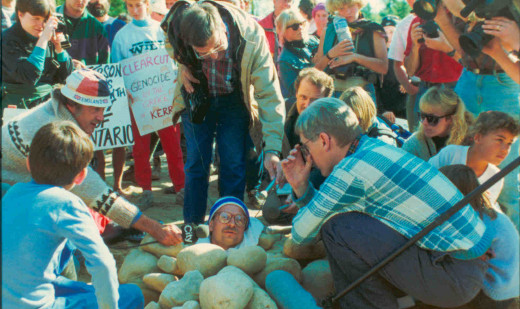
During the Red Squirrel Road blockade, Brian Back was buried in the ground up to the neck. Bob Rae, stunned as he walked by, whispered to him, "are you alright?"
Listen to the story to hear about how old-growth forests and some of Ontario's wilderness canoeing areas were protected.
The Temagami area in northern Ontario holds one of the largest old growth red and white pine forests in the world. Old growth forests are rare in Ontario due to past extensive logging, but Temagami is still standing, thanks to Hap Wilson, Brian Back, Amber Ellis and many others who fought hard to preserve the ancient ecosystem.
I remember fights in [the district manager]'s office ... The door was closed and you'd hear screaming, then you'd hear things hit the wall. This was what it was like there. It was a circus.The Temagami story begins with Hap Wilson: canoeist, outfitter, artist, environment enthusiast, and author of many wilderness guidebooks. As a park ranger from 1976 to 1984, Wilson surveyed and published Temagami’s first, and very popular, Canoe Routes guidebook. This helped lead to a greater awareness of the need for wilderness protection, and opened up the area to outsiders who became advocates through discovery. However, logging and road building were still allowed. Things heated up when a district manager from MNR started illegally clearing land for the Red Squirrel Road in the fall of 1984. Hap was the first to learn about the road clearing, and quickly worked with his supervisor, Reg Sinclair from the Ministry of Natural Resources to "block" particular logging operations scheduled for critical areas by designing hiking trails or new canoe routespushing the development into the review process. In July of 1985, environmentalist Terry Grave and lawyer Owen Smith requested an Environmental Assessment (EA), and lobbied it hard through Queen’s Park for three months. In September 1985, the government finally agreed to conduct the EA. One year later, it was released, but the government had altered the document and removed the author’s name, making it unusable. Nevertheless, the EA was critical to delaying logging and building of the Red Squirrel Road, and gave time for Terry, Hap and activist Brian Back to get organized. In 1986, they formed the Temagami Wilderness Society, with the mission to keep Temagami wild. One of the first things the Society did was to identify a reason for preserving the wilderness in Temagami. In 1988, they commissioned Peter Quinby, a forest-ecology doctorate, to study the Temagami forest. Quinby confirmed the existence of old growth in Temagami – endangered from logging in Eastern Canada. With their cause strengthened by this finding, the Temagami Wilderness Society distributed brochures featuring photos of Temagami, brought people to the area, and campaigned to stop the area from being developed. For several years, the Temagami Wilderness Society did their best to stop the logging of old growth, working hard at public relations and fundraising. However, nothing seemed to stop those who were determined to build the road. In 1989, the government resumed building the Red Squirrel Road through the newly developed Lady Evelyn-Smoothwater Wilderness Park. Finally, the Society decided to set up a blockade at the Red Squirrel Road, the first of its kind in Eastern Canada. You can see the photos of the blockade in the photo section of this story. Today, Temagami is one of the remaining wilderness canoeing areas in the world, as logging and development continue to endanger these precious areas. In Ontario, we are lucky to have legislation and environmental groups to protect these precious landscapes and ecosystems. It is important for the next generation to keep it that way. Listen to the story to learn about the blockade, how Brian Back was buried in the ground, how former Ontario Premier Bob Rae (leader of the opposition at the time) was arrested, and learn what happened to Temagami and the Temagami Wilderness Society.
